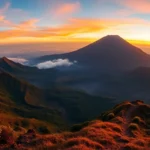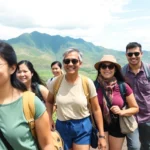Introduction to Mt. Rinjani
Standing majestically on the island of Lombok, Indonesia, Mt. Rinjani is not just a geographical feature but a symbol of volcanic activity, natural beauty, and cultural significance. As Indonesia’s second highest volcano, with an elevation of 3,726 meters, Rinjani captures the imagination of adventurers and nature lovers alike. Its towering presence dominates the landscape, offering a challenging yet rewarding experience for trekkers, scientists, and spiritual seekers. Understanding Mt. Rinjani involves exploring its geographical location, its role in local culture, its recent volcanic activity, and its importance within the broader ecosystem of the region.
Geographical Location and Significance
Mt. Rinjani is situated in the northern part of Lombok, within the boundaries of the Gunung Rinjani National Park, a protected area of immense ecological and geological importance. The mountain resides in the West Nusa Tenggara province, towering over surrounding landscapes and forming a critical part of Indonesia’s volcanic archipelago. The volcano is part of the Pacific Ring of Fire, a zone characterized by high seismic and volcanic activity that contributes to Indonesia’s diverse and dynamic geology.
Spanning over 41,000 hectares, the national park encompasses diverse habitats, from lush rainforests to arid slopes, providing shelter for various flora and fauna. The summit of Mt. Rinjani is not only a prominent topographical feature but also an active volcano influencing regional climate, soil fertility, and water resources. Its caldera contains a sizeable crater lake, Danau Segara Anak, which is a focal point for both scientific study and cultural rituals.
Historical and Cultural Importance of Rinjani
For centuries, Mt. Rinjani has held deep spiritual and cultural significance for the Sasak, Lombok’s indigenous people, and the surrounding communities. The mountain is intertwined with local legends, religious practices, and traditional ceremonies. Its peak is considered sacred, often associated with spiritual cleansing and offerings to appease spirits believed to dwell within the volcano.
The presence of ancient remains and traditional rituals underscores the mountain’s role beyond natural wonder—it is an enduring symbol of identity, resilience, and cultural heritage for Lombok’s inhabitants. Historical records also reference eruptions that have shaped the island’s landscape and affected human settlements. The most recent eruptions, such as the significant activity between 2010-2016, serve as a reminder of the volcano’s ongoing geological dynamism and its influence on local lifestyles.
Understanding these cultural dimensions enhances the experience of trekking or exploring Rinjani, providing visitors with appreciation and respect for its sacred status.
Recent Activity and Volcanic Status
Mt. Rinjani remains an active volcano, with its volcanic activity monitored closely by Indonesian authorities and international experts. The last notable eruption occurred in 2016, which resulted in ash plumes rising to approximately 6 kilometers altitude and lava flows altering parts of the crater and surrounding terrain. These eruptions have prompted safety alerts, temporary closures of trekking routes, and increased scientific research to better understand volcanic patterns.
Despite its active status, Rinjani’s eruptions tend to be intermittent, with periods of dormancy that enable safe trekking seasons. Continuous seismic activity, fumaroles, and gas emissions serve as indicators of potential eruptions. Authorities implement comprehensive risk management plans, including evacuation procedures, to safeguard visitors and local communities.
From a scientific perspective, studying Rinjani’s activity provides valuable insights into volcanic behavior in Indonesia, contributing to global understanding of eruption precursors and hazards. For travelers, staying informed about current volcanic activity ensures safety and enables responsible exploration.
Planning Your Rinjani Trekking Adventure
Best Seasons and Timing for the Climb
The optimal time for ascending Mt. Rinjani falls within the dry season, typically between April to October. During these months, weather conditions are more predictable, with clearer skies, minimal rainfall, and reduced risk of landslides or flash floods. The peak trekking season coincides with Indonesian national holidays and school vacations, so early booking is recommended. Avoid the rainy season (November to March), which not only hampers visibility but also increases trekking hazards.
Required Permits and Regulations
Reaching the summit of Rinjani mandates obtaining the appropriate permits. These are generally arranged through registered tour operators or park authorities. Entry permits support conservation efforts, and trekking regulations aim to minimize environmental impact. Important rules include adhering to designated routes, not disturbing wildlife, and practicing Leave No Trace principles. Sensitive cultural sites also require respectful behavior. Always check current regulations before planning your trip, as policies may evolve.
Choosing Guided Tours vs. Independent Trekking
While independent trekking provides flexibility, guided tours are highly recommended for safety, logistical support, and ecological responsibility. Guided operators handle permits, provide experienced guides, arrange accommodations, and assist during emergencies. They also enrich the experience by sharing local knowledge, cultural insights, and safety tips. For those undertaking the trek independently, expertise in navigation, high-altitude trekking, and emergency protocols is essential. Overall, guided expeditions significantly enhance safety and environmental stewardship on this challenging mountain.
Preparing for the Mount Rinjani Ascent
Essential Equipment and Clothing
Preparation is key when tackling Rinjani’s rugged terrain. Essential gear includes sturdy hiking boots with good ankle support, layered clothing to adapt to temperature fluctuations, windproof and waterproof jackets, thermal base layers, gloves, and a hat for sun and rain protection. A high-quality sleeping bag and tent are necessary if camping, along with a headlamp, extra batteries, and a portable power bank. Packing lightweight but durable essentials minimizes burden while ensuring safety.
Physical Fitness and Training Tips
Trekking Mt. Rinjani demands high physical endurance. Preparation should include cardiovascular training such as running, cycling, or swimming, combined with strength exercises targeting legs, core, and back. Long hikes with loaded backpacks simulate trek conditions and boost stamina. Flexibility and balance exercises help navigate uneven paths, while altitude acclimatization is crucial. Gradual training over several months ensures readiness, reducing risks of altitude sickness and fatigue.
Safety Precautions and Risk Management
Safety measures encompass thorough planning, knowledge of the terrain, and understanding weather forecasts. Trekking with experienced guides drastically improves risk management. Carrying a first aid kit, oxygen supply, and communication devices like satellite phones is essential. Monitoring volcanic activity through official channels prevents exposure to eruption hazards. Always respect your physical limits, hydrate adequately, and prepare for emergencies such as falls or sudden weather changes.
Trail Routes and Key Highlights
Popular Trekking Paths: Sembalun vs. Senaru
Two main routes lead adventurers to the summit: the Sembalun route and the Senaru route. Each offers distinct experiences. The Sembalun trail, situated on the eastern slopes, is characterized by open plains, lush fields, and gentle ascent, making it suitable for acclimatization and beginners. The Senaru route, on the northern side, features dense forests, waterfalls, and more rugged terrain, favored by experienced trekkers. Both routes converge at the crater rim, leading to the summit and caldera.
Major Landmarks and Scenic Spots
Key landmarks along the trek include the Post 1 and Post 2 rest points, the Segara Anak Lake nestled within the crater, and the breathtaking views from the summit, where panoramic vistas of Lombok, the surrounding islands, and the distant Mount Agung in Bali can be witnessed. Other scenic highlights encompass waterfalls en route, volcanic craters, and various endemic flora and fauna, enriching the trekking experience.
Average Duration and Expected Difficulty
The typical ascent spans 2 to 4 days, depending on fitness levels and chosen routes. The ascent involves steep sections, loose volcanic ash, and high-altitude challenges. The trek’s difficulty is rated moderate to difficult, demanding stamina, proper acclimatization, and mental resilience. Proper planning, rest periods, and hydration are vital for an enjoyable and safe journey.
Post-Climb Experience and Conservation
Environmental Responsibility on Rinjani
Preserving Rinjani’s pristine environment requires responsible tourism practices. Visitors must adhere to established trash disposal protocols, avoid unnecessary disturbance to wildlife, and refrain from damaging vegetation. Participating in park-led conservation programs and supporting local eco-friendly accommodations fosters sustainable tourism. Educating oneself on the mountain’s fragile ecosystems encourages respectful interaction with nature.
Local Culture and Community Engagement
Engaging with local communities enhances the trek’s cultural depth. Visiting nearby villages, participating in traditional ceremonies, and purchasing handcrafted souvenirs support livelihoods and promote cultural exchange. Respecting local customs, dress codes, and rituals fosters mutual understanding and appreciation.
How to Support the Preservation of Rinjani
Supporting conservation efforts involves choosing authorized tour operators, following park regulations, contributing to community projects, and spreading awareness about responsible travel. Donations to local conservation initiatives or volunteering for environmental activities further aid in maintaining Rinjani’s natural beauty for future generations.







